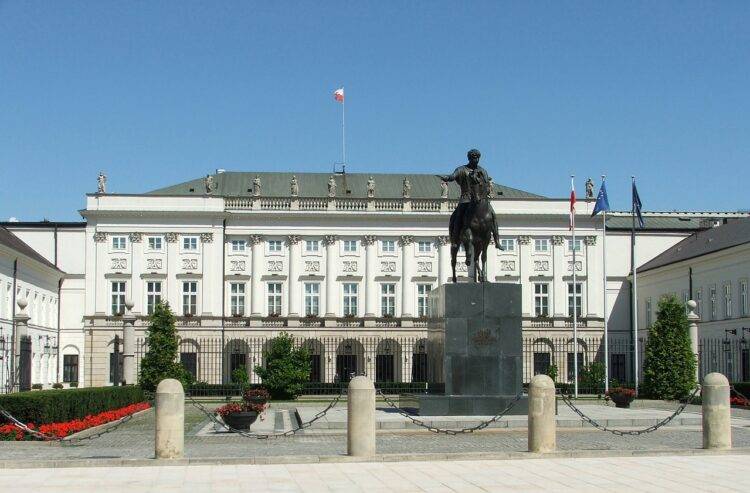On the coming Tuesday and Wednesday, the President’s office has extended an invitation for discussions with representatives of various electoral committees that will form their delegation in the X term of the Sejm, as announced on social media channels by the Presidential Chancellery.
- More News from Poland on our Homepage.
- Sign up to our Newsletter to receive a weekly recap and stay informed about current events in Poland
- Don’t forget to follow us on Facebook.
“Each electoral committee will be met individually, in the order corresponding to the results achieved in the elections,” according to the Chancellery.
In a discussion with Bogdan Rymanowski on Radio ZET, Andrzej Duda’s social advisor, Marcin Mastalerek, revealed that the President will sequentially invite all the committees for consultations regarding the initial step of government formation.
“The term of this Sejm continues until November 14. There is no reason to cut this term short,” responded Andrzej Duda’s advisor when asked about Donald Tusk’s appeal to the President.
He added the first invited committee would be the victorious one, Law and Justice. The rest of the committees, which scored lesser, will be invited next.
During the program, Marcin Mastalarek also assured potential collaboration between the President, supported by the incubent PiS, and a possible opposition Prime Minister, stating, “this cooperation is necessary for the smooth functioning of Poland.”
Wybór nowego rządu. Możliwe scenariusze
Konstytucja przewiduje trzy możliwe kroki wyłonienia rządu po wyborach. W pierwszym dużą rolę odgrywa prezydent, który zwołuje posiedzenie Sejmu i Senatu na dzień przypadający w ciągu 30 dni od dnia wyborów. Na pierwszym posiedzeniu Sejmu nowej kadencji dotychczasowy premier musi złożyć dymisję, a prezydent musi taką dymisję przyjąć. Rząd w stanie dymisji sprawuje obowiązki do czasu powołania nowej Rady Ministrów.
Następnie – jak czytamy już na stronie internetowej prezydenta:
“W myśl art. 154 Konstytucji, Prezydent desygnuje Prezesa Rady Ministrów. Jest to zazwyczaj osoba wskazana przez większość parlamentarną. Desygnowany Prezes Rady Ministrów proponuje Prezydentowi skład Rady Ministrów. Następnie Prezydent powołuje Prezesa Rady Ministrów i pozostałych członków rządu w ciągu 14 dni od dnia pierwszego posiedzenia Sejmu lub przyjęcia dymisji poprzedniej Rady Ministrów i odbiera przysięgę od członków nowo powołanej Rady Ministrów”.
Oficjalna strona internetowa Prezydenta RP
“Premier, w ciągu 14 dni od dnia powołania przez Prezydenta, przedstawia Sejmowi program działania Rady Ministrów (tzw. expose) z wnioskiem o udzielenie jej wotum zaufania” – dodano na oficjalnej stronie Prezydenta RP.
Prezydent desygnując premiera bierze pod uwagę, że zaproponowany przez niego rząd, aby uzyskać wotum zaufania, musi zdobyć poparcie bezwzględnej większości w Sejmie. Jeśli Rada Ministrów nie uzyska wotum zaufania, to inicjatywę w tworzeniu rządu przejmuje Sejm.
Jest to już drugi możliwy scenariusz powołania rządu. W tym konstytucyjnym kroku kandydata na premiera może zgłosić grupa co najmniej 46 posłów. Sejm wybiera premiera większością bezwzględną w obecności co najmniej połowy ustawowej liczby posłów. Następnie szef rządu przedstawia Sejmowi program działania rządu oraz proponowany skład Rady Ministrów. Sejm wybiera ministrów bezwzględną większością w obecności co najmniej połowy ustawowej liczby posłów. Jest to forma udzielenia rządowi wotum zaufania. Sejm na wybór premiera i rządu ma 14 dni. Prezydent nie może odmówić powołania i zaprzysiężenia tak wybranego rządu.
Kolejny krok przewidziano, jeżeli Sejmowi nie udałoby się stworzyć rządu. Wtedy prezydent w ciągu 14 dni powołuje premiera i na jego wniosek członków rządu oraz odbiera od nich przysięgę. Po powołaniu przez prezydenta Rada Ministrów ma 14 dni na uzyskanie w Sejmie wotum zaufania. W tym konstytucyjnym kroku Sejm udziela rządowi wotum zaufania zwykłą większością głosów (w dwóch poprzednich krokach konieczna jest większość bezwzględna) w obecności co najmniej połowy ustawowej liczby posłów.
Jeśli za trzecim podejściem nie uda się wyłonić rządu, prezydent musi skrócić kadencję Sejmu i zarządzić wybory.
Forming of the new government in Poland. Possible scenarios
The constitution provides three possible steps for forming a government post-elections. Initially, the president plays a significant role by calling the Sejm and Senate session within 30 days of the election. At the first session of the newly-elected Sejm, the incumbent Prime Minister must resign, and the President must accept this resignation. The resigning government continues to discharge its duties until the new Council of Ministers (Polish name for the government) is appointed.
Next, as per the President’s official website:
“The Prime Minister, within 14 days of being appointed by the President, presents the Sejm with the program of action of the Council of Ministers (also known as “expose”) with a request for a vote of confidence” – as added on the official website of the President of the Republic of Poland.
While designating the Prime Minister, the President considers that to gain a vote of confidence, the proposed government needs the absolute majority’s support in the Sejm. If the Council of Ministers appointed by the President doesn’t get the vote of confidence, the task of government formation is taken over by the Sejm.
This is the second possible scenario. In this constitutional step, the candidate for Prime Minister may be nominated by a group of at least 46 deputies (MPs). The Sejm elects the Prime Minister by absolute majority in the presence of at least half of the statutory number of deputies. Then, the head of government presents to the Sejm the government’s action program and the proposed Council of Ministers. The Sejm elects ministers by absolute majority, in the presence of at least half of the statutory number of deputies. This is considered giving the government a vote of confidence. The Sejm has 14 days to vote for the Prime Minister and the government. The president has no right to refuse the appointment and the swearing-in of the elected government.
Yet another step is if the Sejm fails to establish a government. The President shall appoint a Prime Minister and government members at his request and accept their oath within 14 days. Following appointment by the President, the Council of Ministers has 14 days to secure a vote of confidence in the Sejm. In this constitutional step, the Sejm grants the government a vote of confidence by a simple majority (in the two previous steps, an absolute majority is required) in the presence of at least half of the statutory number of deputies.
If the third attempt to form a government does not succeed, the President must shorten the Sejm term and arrange for elections.
Election Results
Official results from the Sejm and Senate elections were announced on Tuesday
The best voting results for MPs were achieved by PiS – at 35.38%. This result, however, does not grant the ruling party independent governance. They will secure 194 mandates when the majority is 231.
The new government will likely be formed by Civic Coalition (30.70%, 157 mandates), Third Way (14.40%, 65 mandates), and New Left (8.61%, 26 mandates).
The Confederation, which received votes from 7.16% of the people, will also enter the Sejm, with 18 Sejm seats.


















